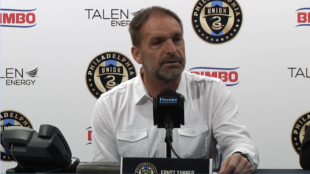Feature Photo PSP & the Union
Since his arrival Ernst Tanner has emphasized the importance of developing players 17 to 21 years-old, in his view that is the time they take the greatest strides towards becoming successful professionals. So we asked Dr. Nooha Ahmed-Lee, Head of School at the YSC Academy Schoolhouse, whether Tanner’s age focus was borne out by state-of-the-art educators’ understandings of adolescent development.
The short, over-simple version of her thorough and complete answer is “Yes.”
Some basics
Ahmed-Lee focused specifically on the growth and development of the human brain during childhood and adolescence. Adolescence was her primary focus since it is the ages at which student-athletes are involved with the Union’s Academy on the pitch and in the schoolhouse, Bethlehem Steel, and in some cases the Union.
Throughout the brain’s development from birth to 24 years of age, the synaptic pathways in the brain that experience frequent use are strengthened by that use. She characterized the strengthening as actual physical growth, stating that from age 11 unused pathways (synapses) begin to be pruned as the brain transitions from childhood into adolescence.

Courtesy Dr. Nooha Ahmed-Lee
Synaptic pruning is the process by which extra neurons and synaptic connections are eliminated in order to increase the efficiency of neuronal transmissions. (See the figure to the left.)
Using foreign languages as an example, Ahmed-Lee said that by age 11 an individual begins to lose the capacity to learn other languages easily because repetition has strengthened the pathways associated with the mother tongue, and pruning has begun to remove the pathways that would have serviced the others.
Brains grow
She sketched out five age-segmented stages of the brain’s cognitive development.
The brain's cognitive development
| Age | Stage | "Executive Function Skills" (See subhead below) | Soccer-Specific Skills |
|---|---|---|---|
| 0-5 | Childhood | ||
| 6-10 | Childhood | ||
| 11-14 | Early Adolescence | Beginning | Beginning individual technical skills, the simplest of tactics, rote more than creativity |
| 15-17 | Mid-Adolescence | Improving | Advanced individual technical skills, simple creativity in simple tactical situations |
| 18-24 | Late Adolescence | Transitioning to automatic | Fully integrating individual technical skills into wider tactical situations and making them into automatic, instant responses |
She described the brain during the two childhood periods as a sponge, absorbing everything into Michelangelo’s uncut block of marble.
Around age 11 individuals start to forget things (synaptic pruning), whether those things be tangible schoolbooks or less tangible appointments, by way of examples. The children are not bad or regressing. Their brains are editing themselves to reconcile historically accumulating patterns of use with finite brain capacity.
In terms of soccer, starting around age 11, players should be repeatedly exposed to individual technical soccer skills such as trapping, passing, shooting, tackling, and heading, (within the controls necessitated by avoiding concussions of course). Just as early adolescent basketball players must learn to dribble with their non-dominant hands, so early adolescent soccer players must learn to trap, dribble, and shoot with their non-dominant feet.
“Executive function skills”
Early adolescence is also the beginning of the growth of the prefrontal cortex that continues throughout all three age-stages of adolescence. The process “speaks to” Tanner’s focus.
After late adolescent growth ends, synaptic pathways are much more set, and it becomes much harder to add new ones to those already established. For this reason players like Ray Gaddis, Cory Burke, and Ilsinho who have have invested lots of hard work improving themselves as mature adult players deserve corresponding levels of credit.
The prefrontal cortex is the center of what Ahmed-Lee called executive function skills, in the word’s most basic sense of “executing,” or “carrying out”. (In soccer terms, this is where and when game intelligence – soccer IQ – really takes off). She mentioned several such skills.
- Previewing, pre-planning, and anticipating. (“Reading the game.”)
- Knowing the right sequence of steps to take in a situation. (Angles of retreat and attack.)
- Visualization.
- The ability to hold back emotionally impulsive decision-making and instead apply rational and experience-based analysis.
- The ability to manage and integrate time, space, and materials.
The neural pathways that perform the executive function skills are developed and then perfected through repetition. The more you use those pathways the stronger they get.
Conscious thought becomes automatic reaction. Ages 18-24 is when the brain has developed enough for a soccer player to sense automatically that which is tactically appropriate, particularly with a professional’s speed of mind. In the highlights from January 30th watch Ilsinho’s perfectly weighted pass that barely beats the Red Bulls center back and allows Cory Burke to score the first Union 2019 preseason goal. The Brazilian did not think, he just acted.
Ahmed-Lee closed by asserting that the human brain is designed to do “higher order thinking,” the “analysis,” “synthesis,” and “evaluation” from the Arthur Bloom taxonomy so famous among educators. From ages 18-24 (21 in women Ahmed-Lee said) higher order thinking is being perfected.
Caveats
The ages Ahmed-Lee used are norms not absolutes.
And adolescent development is not limited to the brain. It is also physical, hormonal, social and whatever else we are forgetting.
February 2018’s gawky awkward Ben Ofeimu did not evolve only through brain development to shut down Louisville’s league-leading scorer by the late October playoff game. He worked hard on the pitch and in the gym. But his brain perfecting its soccer-specific executive function skills certainly helped frustrate Cameron Lancaster.
It will be fun to watch how far Ofeimu is able to take his improvement, just as it is fun watching Derrick Jones, Auston Trusty, Mark McKenzie, Anthony Fontana, Matt Real, Brenden Aaronson, Michee Ngalina and Faris doing the same.
And now there will be seven or eight new Bethlehem players, and a few Academy boys, to monitor as well.


Good article and just the beginning of a youth movement for U.S.soccer. I know those who believe in pro/rel don’t believe there can be a different path but you are starting to see the first fruit from a system that was mandated just twelve years ago.
The Athletic has an article today about USL academies and is an interesting read it you are a subscriber. This jumped out at me from the article.
Currently, seven independent USL Championship and League One clubs have their own development academies. Another 10 are aligned with youth soccer clubs in their markets. And a further 12 are exploring the possibility of opening a development academy, according to a league spokesperson.
One measure of the quality of these players is their involvement in the U.S. national team program. Of the 20 players called into the most recent U.S. under-18 national team camp, 10 are in MLS academies, two are signed by MLS teams to USL deals and four come from independent USL academies—two from Sacramento, one from Saint Louis FC and one from San Antonio.
Even as some MLS teams question the importance of the academy system, lower division teams are putting more investment into it.
Solid commentary. I’d argue building these youth academies across USL is a very very important component to a potential push for an open pyramid. The pathway to the first team begins with a child.
.
Tim. Thank you for the time and energy to discuss the Science behind youth development.
.
One point of contention for me is the ages at which the article argues for the entrance of ‘simple’ tactics.
.
If a kid can learn multiple languages before pruning. If a kid is able to be taught and learn advance tactical concepts on a chess board before 11… we should expect the same of them on the football field.
.
American soccer vastly underrates the intellectual ability of US players. We can hope MLS academies are beginning to address these enormous gulfs of age appropriate tactical understandings. It is why, the average 11 year old kid, when dropped on a field in Spain has the understanding of an 8 year old.
.
Most US players are (still) 3 and 4 years behind players from the rest of the world because the foundational education of those players is totally different. In America we (continue) to isolate technical skills as though a step over ever solved anything on a field.
.
In the rest of the world, technical skills are assimilated into a technical -tactical exercise. Form the earliest ages of youth development abroad, coaches present age appropriate problems for kids to solve. Here we teach them to dribble, trap and pass.
.
Thanks, El P. Glad to be of service.
.
Yes, I was conservative in my judgments about the skills. My own personal experience with non-soccer skills is in line with your view, but I am a data set of one. And I did point out the ages are norms.
.
The other point is to remind the both of us that Tanner’s goal is Ilsinho-like speed of execution. The foundation can certainly be laid much earlier. Whether it becomes automatic and instantaneous significantly earlier, I have no way to tell.
.
Certainly we both know that Earnie Stewart thought he had something special in the lower levels of the Academy more than a year before he left. The individual was a precocious outlier of course, and Dr, Ahmed-Lee was speaking in generalities about population norms.
be careful. these things can be a little complicated. After the age of 6 or so , the ability to learn a language without an accent diminishes rapidly. Chess does not place big physical demands or the need for co-ordination on a youngster. At a young age, pattern recognition regarding play is critical, so maybe you mean fewer cones. more play, more pattern repetition and recognition.
One of the most quality articles I’ve ever seen on PSP.
.
Truly interesting and thought provoking.
Very nice and thought provoking! As a young player in the late 70s and early 80s I had a hard time learning the foot work and ball skills to play the game. I didn’t even touch a soccer ball till I was 13 or 14. I’m so glad that this came up. You guys rock!